
Ever spent a meeting on your feet? If not, you might want to consider it.
A huddle, also known as a stand-up meeting, is a Scrum framework staple, widely used today by countless software development teams.
However, as you’ll learn below, the point of this type of meeting isn’t the actual physical act of standing up (although that also has its benefits).
The meeting’s charm lies in its quick yet dynamic format. It can supercharge your team’s performance in just 15 minutes, boosting productivity and collaboration.
Keep reading to find out how!
Table of Contents
What are huddles or stand-up meetings
A huddle, also known as a stand-up meeting, is a brief, recurring, intensive daily meeting that the entire team attends.
Usually held first thing in the morning, such a meeting rarely extends 15 minutes, yet is still efficient enough to devise the whole game plan for that day.

Get unreal data to fix real issues in your app & web.
The idea behind huddles is to facilitate transparency, ensuring that all team members are aligned and focused on the project’s objectives.
To achieve this, all employees answer the following questions:
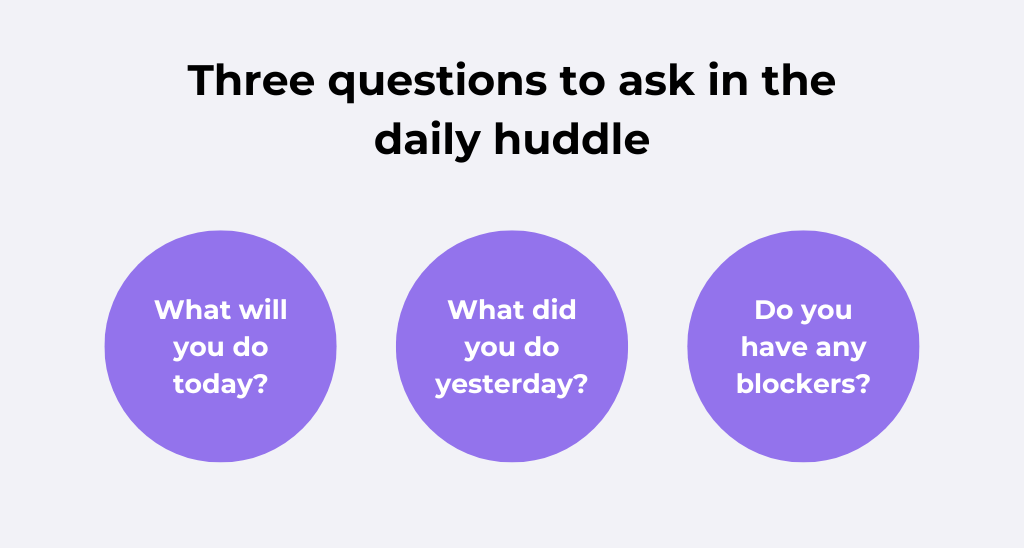
Answers shouldn’t be longer than two sentences, and it should take less than one minute to cover all three questions.
Once each team member has provided their answers, you’ll have a succinct yet clear overview of the project’s current status and, if necessary, will be able to re-distribute or re-organize responsibilities.
The ceremony has become hugely popular because it allows tasks to be reviewed easily and brings attention to issues before they escalate.
Nowadays, most Agile teams incorporate a daily huddle, but the practice’s origin is as early as the 1990s.
In a 1994 study, eight developers wrote one million lines of code in 31 months. As James O. Coplien explains, one of the project’s staples was a daily meeting sync:
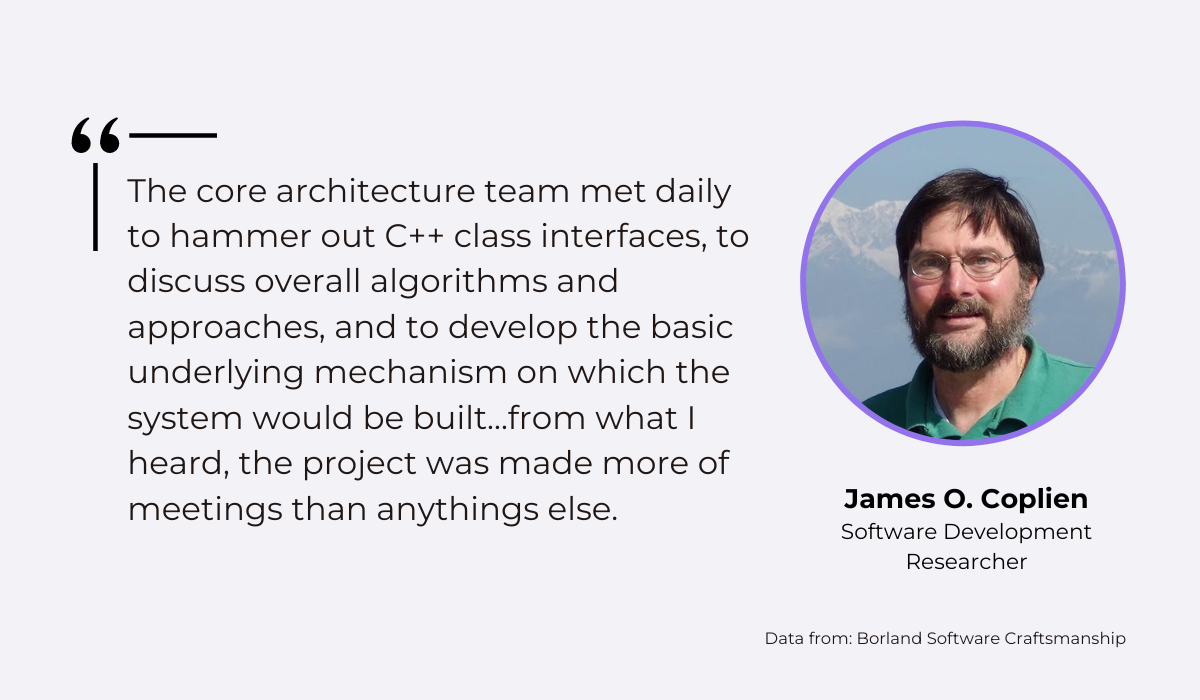
These developers’ daily meetings are part of the reason they were such a high-performing team.
Without even knowing it, they set a precedent for one of modern software development’s most popular methodologies.
What are the benefits of huddles
Designed to streamline communication and collaboration, huddles give teams a chance to come together and collectively check their progress.
Employees have the perfect opportunity to discuss issues, plan for the workday, and celebrate any milestones.
Jeff Sutherland, co-creator of the Scrum framework, describes the success his team had when they first implemented their daily Scrum (another term for the daily huddle):
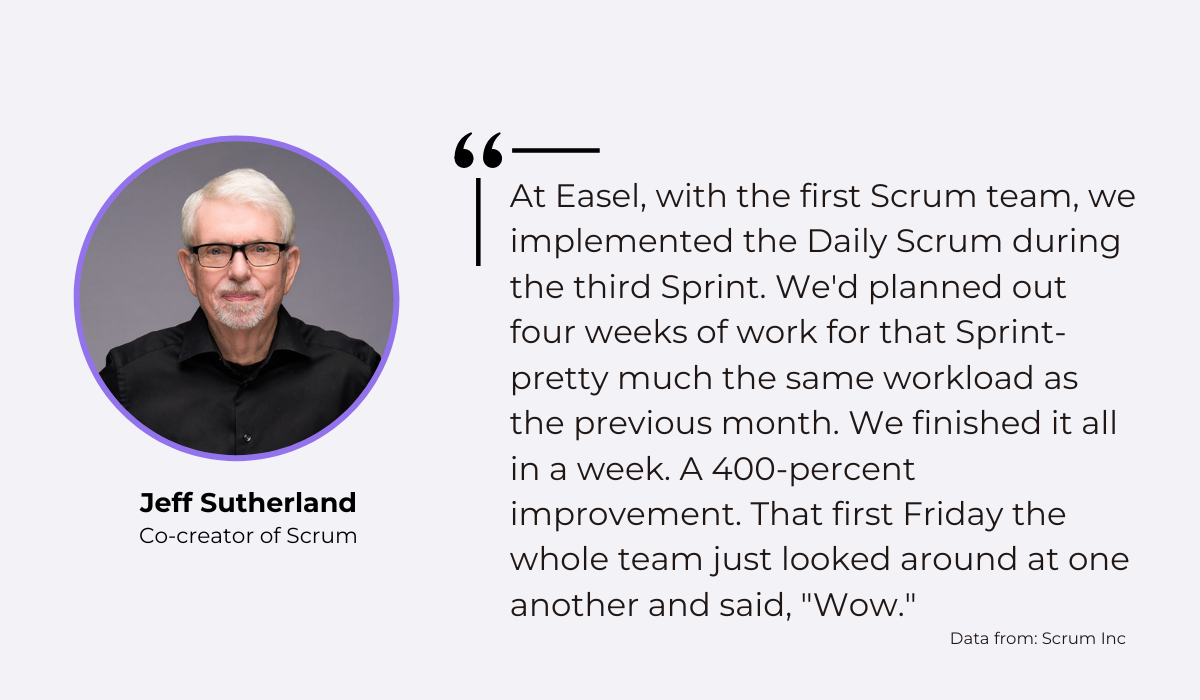
His team experienced an unbelievable 400% improvement in their processes, cementing the daily huddle as a beneficial workplace ceremony—in more ways than one.
They save time
Although they’ll take 15 minutes out of your day, daily huddles save time in the long run. Since the meetings are so short, employees must share information quickly and efficiently.
There’s no time for going off on tangents or beating around the bush.
By being strict about the 15-minute time limit, you force your developers to be concise yet informative, saving everyone from needless future long-running meetings.
Everything can be laid out in those initial 15 minutes.
The Scaling Up author perhaps described the effect best:

When your team members provide a rapid-fire report of their current progress, the effect is the same as if they had emailed you—except the daily huddle is much faster.
With the huddle format, no time is lost composing emails, and all team members receive real-time updates.
Furthermore, you can all debate right then and there as well, whereas communication tools, while effective, tend almost always to be slower than traditional face-to-face conversations.
They improve team communication
The daily huddle is the ideal environment for team communication. In a perfect world, all team members would communicate with one another of their own accord.
However, employees sometimes hesitate to do so out of embarrassment or simple forgetfulness.
The daily huddle ensures those situations don’t happen and incite team communication every morning.
This Reddit user described the crux of the matter well:
During the daily huddle, your developers will be forced to speak up about their current status as they answer the three questions.
Consequently, everyone present immediately learns about the team’s priorities, challenges, and wins. Information flows much more freely.
Furthermore, when team members communicate like this daily, they will begin to trust and rely on one another.
As they become more comfortable with one another, informal, natural communication will become more and more commonplace, even outside the daily huddle.
They are easy to set up
Daily huddles have one huge benefit over most meetings: you only have to organize them once.
The typical meeting requires extensive coordination to find a time that works for everyone, and this difficulty only increases as more participants join.
Daily huddles, on the other hand, are a recurring event in your calendar.
They always happen at a constant, fixed time, and the only time you’ll need to juggle multiple schedules is with the initial setup.
Once you’ve figured out a time that works for everybody, you’re pretty much set!
This scheme is quite fitting when you consider one of Agile’s twelve principles:
The sponsors, developers, and users should be able to maintain a constant pace indefinitely.
12 principles behind the Agile Manifesto
In other words, maintaining a steady daily huddle rhythm perfectly aligns with one of Agile’s credos.
Another feature that makes the daily huddle easy to set up is its timing.
Since it’s recommended to hold huddles first thing in the morning, they rarely interfere with other meetings or obligations. In fact, most daily huddles are held at 9 am sharp.
They allow immediate problem-solving
If something isn’t going as planned, you’ll want to know about it as soon as possible. That way, you can nip the problem in the bud.
This is where the daily huddle excels. Since these meetings are, well, daily, your developers will generally report problems less than 24 hours after they encounter them.
If any issue should crop up on a Friday, you’d still learn about this issue 72 hours later at the latest (on Monday).
Because of these instantaneous updates, you can work on possible solutions immediately before things get out of hand.
By resolving matters quickly, you’re likely to keep the project on track.
Here is a great example of quick problem-solving:
E.g. there is a team of three working towards Goal X. Member 1 is working on item A, 2 on B, 3 on C to get us to Goal X. Each reports what they did on their items to get us to the Goal, but we start to learn some things: let’s say Member 3 found that item C is taking way longer than expected, and the team has decided that it’s not absolutely needed to complete the Goal, while Member 1 is working on item A but is stuck and needs some help, and the team knows this work is critical to the Goal. The team might take Member 3 off of C and put her with Member 1 to double up on item A to ensure that’s done while de-prioritizing item C until A is complete.
This type of efficient damage control is only manageable with constant updates from all team members.
If even one team member was absent and the problem stayed unreported, even something as small as a two-day delay could significantly postpone the project.
How to structure huddle meetings
To reap the full benefits from the daily huddle, ensure your meetings follow a set structure. They’ll be much easier to host with a pre-determined template.
When building the meeting structure, ensure you incorporate the three pillars of Scrum—three characteristics on which the entire Scrum methodology is based.
Those are:
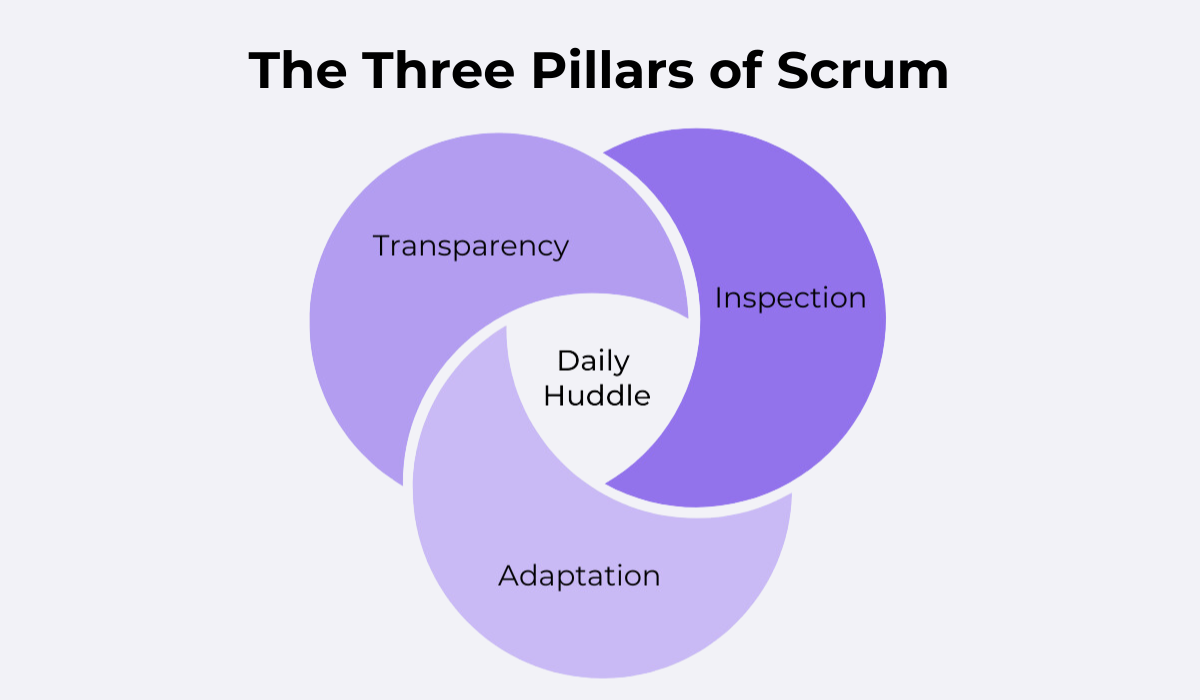
Transparency ensures all team members are up to speed on their colleagues’ work, inspection assists with assessing the work done so far, and adaptation encourages everyone to forgo their own individual goals and concentrate on the collective team goal.
Discuss the previous day
It’s always a good idea to start a daily huddle by discussing the previous day. You can incite this conversation by asking your developers a simple question: “What did you do yesterday?”
Have all your team members answer this question, and you’ll have a clear vision of what was accomplished yesterday and what still needs doing.
If by any chance your employees didn’t finish something they should have, this is when you’ll find out.
One Reddit user described their own experience with this question:
By constantly keeping tabs on what was done yesterday, you’ll have a consistent, up-to-date, and detailed overview of the project’s progress.
Furthermore, you can use this opportunity to congratulate your employees on any breakthroughs or give them brief feedback on their accomplishments.
Discussing the previous day is also a powerful motivation booster.
Hearing how a project is progressing should inspire all meeting participants, and they should be encouraged to devote their own efforts to the project’s success.
Share priorities of the day
After recapping the day before, the next step of the daily huddle should be sharing that day’s priorities and summarizing the plans for the day.
You can begin this conversation by asking another simple question: “What will you do today?”
By providing day-to-day transparent updates on one’s tasks, you’ll foster a culture of accountability.
When your developers announce their plans, their team members will expect those plans to be fulfilled. There’s very little room for procrastination.
In fact, a research paper discovered that progress monitoring is most beneficial with goal attainment when the outcomes are made public:
Progress monitoring had larger effects on goal attainment when the outcomes were reported or made public…The findings suggest that monitoring goal progress is an effective self-regulation strategy
Harkin et al.
Does monitoring goal progress promote goal attainment?
Data from: National Library of Medicine
When developers commit to a task publically, they’re much more likely to deliver on that commitment simply due to their peers’ expectations.
Besides accountability, sharing your daily priorities is also helpful for aligning the teams and their members.
With a daily update, everyone has unfiltered visibility into each other’s progress and can then easily adjust their workday if needed.
Ask for updates
Once you’ve heard your developers’ plans for the day, take the time to ask them about any updates.
No new developments must slip under your radar. Just imagine you haven’t heard about the latest UI/UX adjustments—you might revamp a perfectly working codebase through sheer ignorance of the newest business decision.
If every few meetings your developers are announcing that they had to rewrite their code, this is a sign to buckle down and focus on improving that KPI. In other words, it’s a sure sign of an organizational fallacy that needs to be corrected.
Kevin Railsback, a VP of Technical Operations, has emphasized how beneficial KPI management can be:
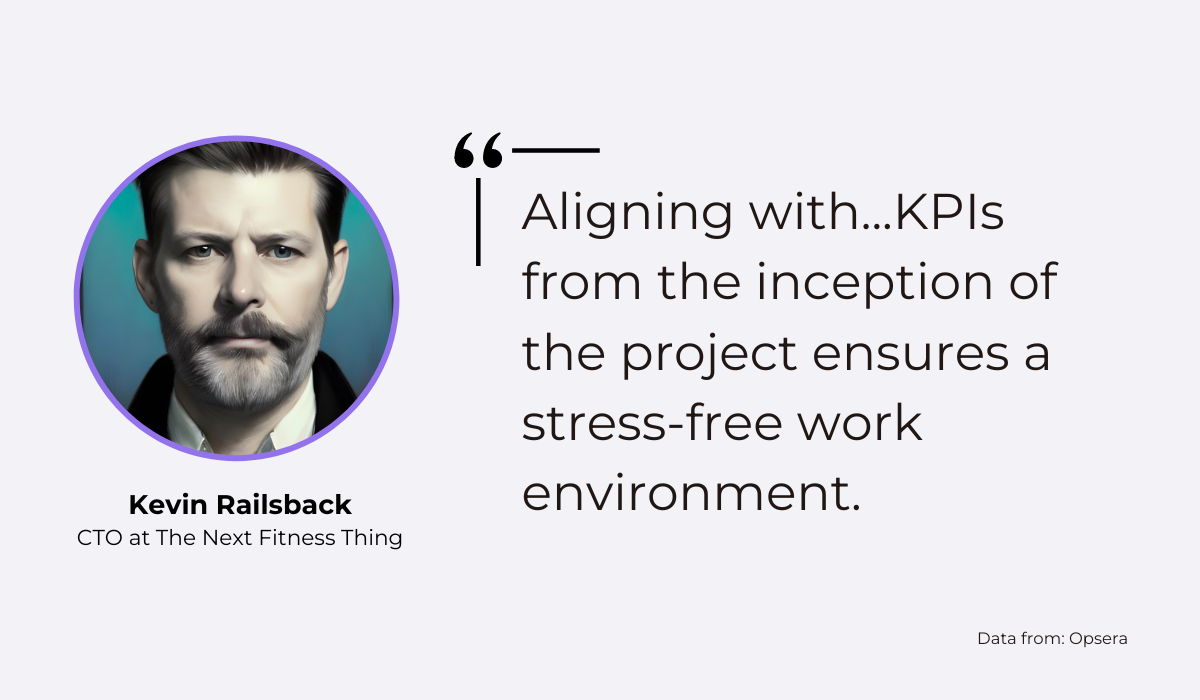
By staying on top of your employees’ updates and evaluating their performance in the context of your business’s KPIs, you’re well on your way to creating an unruffled, productive atmosphere.
Encourage asking questions
Lastly, close the daily huddle with a round of questions from your team members. Encourage your developers to ask what’s on their minds and to voice any doubts.
This part of the daily huddle is essential. It is likely that, if one employee has a question about the current project, your other team members are also a little confused.
By answering this question in the earshot of your entire team, you’re likely clearing up confusion for most. That way, you help everyone stay on track.
However, your developers may be too embarrassed or intimidated to ask questions during the meeting.
To combat this, you can ask your team members to write their questions or concerns on cards before the actual huddle.
Here are some example question and concern cards:

By collecting these anonymous comments before the meeting, you help your employees retain their anonymity while still addressing their concerns.
Who should attend huddles
Do your best to gather your entire team for the daily huddle. This meeting is a team event designed to facilitate collaboration between all team members.
As soon as one member is absent, it’s impossible to achieve 100% transparency.
Obviously, you as the team lead should host the meeting, and everyone who directly reports to you should also attend.
However, given the meeting’s 15-minute timeframe, large teams might not have the most effective huddle.
If your team is larger than ten people, it might be worth splitting the group into two smaller teams and assigning team leads to report directly to you.
That said, huddles don’t have to be done only on a junior level—it’s also worthwhile for the senior leaders to huddle.
For example, you as a Development team lead would benefit from huddling with the QA and DevOps team leaders after meeting with your team and they with theirs.
The VP of Engineering could be the host in that huddle.
Take a look at the image below, it visualizes the concept well:
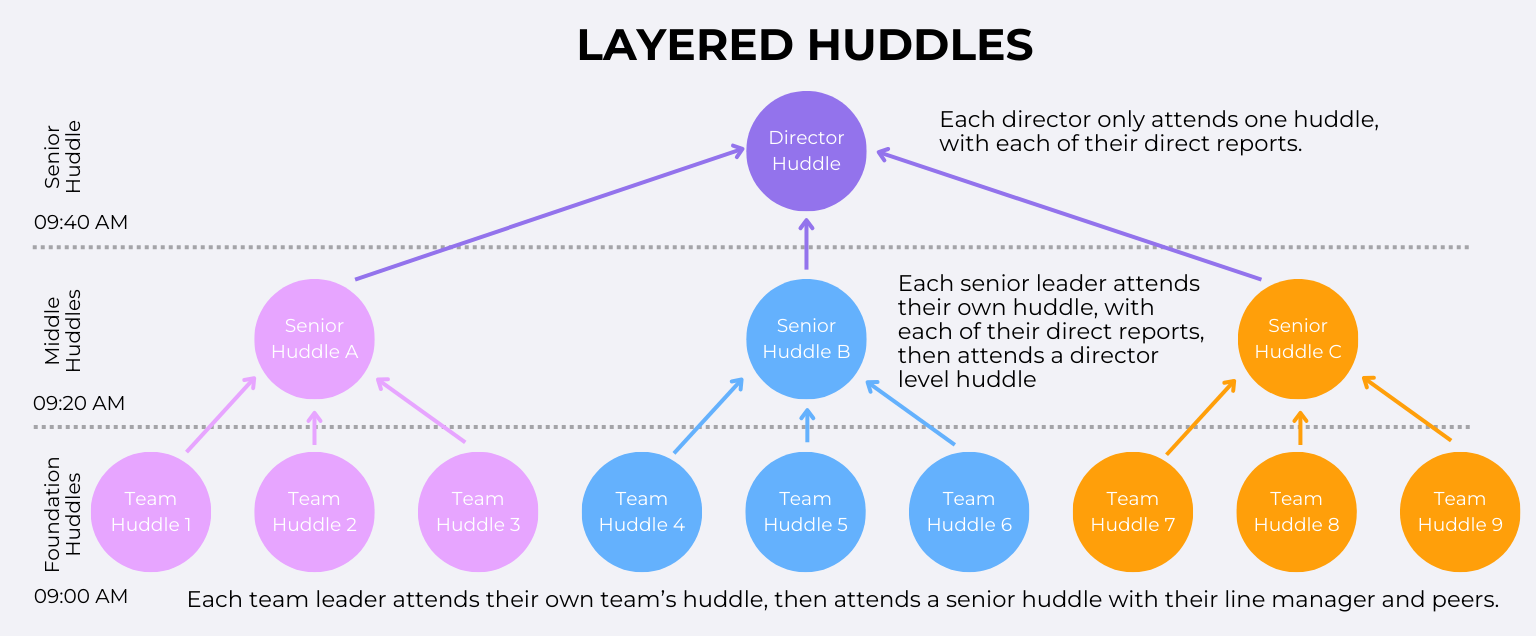
With this structure, team leaders can easily align with their fellow senior-level colleagues to ensure they’re all working towards a shared goal.
Telstra has taken this approach, and the company’s CEO reports fantastic results:
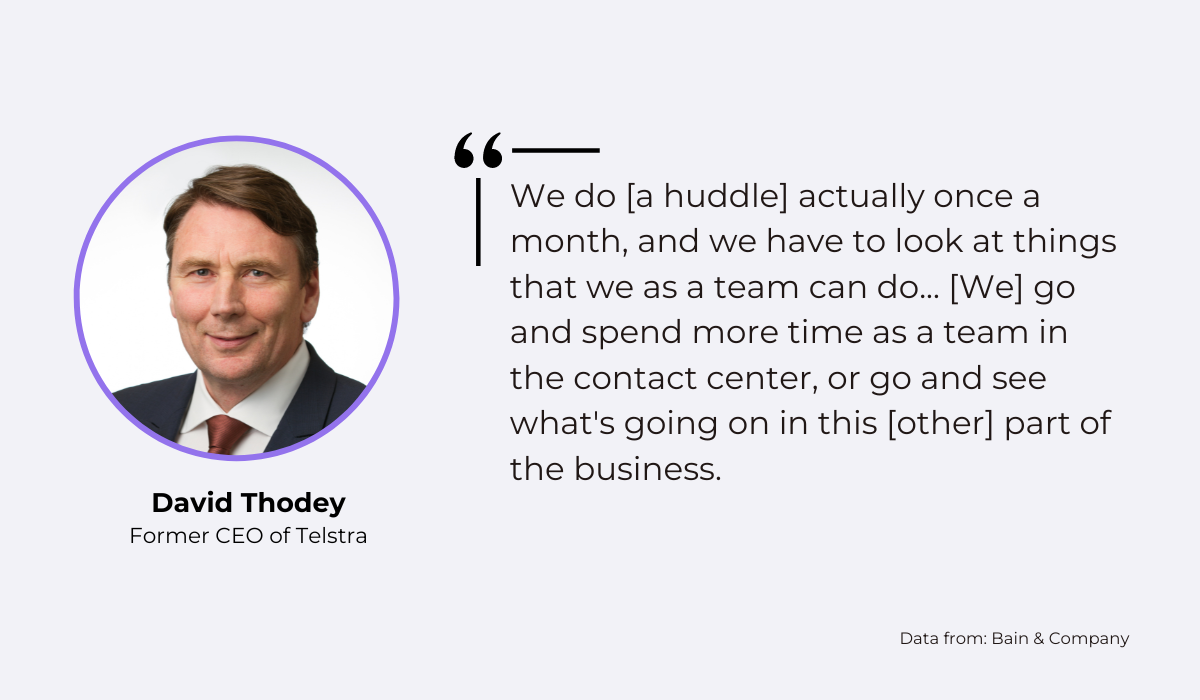
Although not a daily huddle, the organization still profited from this monthly senior-level huddle.
If you have the time, you’d do well to establish similar regular huddles on all organizational levels.
Challenges of huddles
Huddles can be a fantastic tool—if used correctly. Although they’re an excellent medium for efficient team alignment, they come with several challenges.
A common temptation is to go over the 15-minute timebox, wandering off into broader topics unsuitable for this dynamic meeting style. Take a look at this developer’s Reddit testimony.
This overtime is counterproductive to your developers’ productivity—enabling precisely what the daily huddle is trying to prevent.
To avoid exceeding the time limit, devise a clear agenda and stick to it.
By adhering to your pre-determined, timed plan, you can cut the meeting off when you notice topics taking too long or veering off on a tangent.

Very handy for handling user feedback. CTOs, devs, testers – rejoice.
Another challenge with daily huddles is organizing teams that don’t start simultaneously. For example, what if half your team comes in at 10 am, and the other begins at 7 am?
What if they’re spread across different time zones?
The solution is asynchronous daily huddles: a meeting each team member attends whenever they’re available.
You can conduct asynchronous communication with Friday. This tool allows you to choose your custom questions, configure them to recur daily, and then send the prompts to your team.
Here’s a sample question below:

With this setup, your team will send in their reports as soon as possible, and there’s no need for synchronous communication.
Despite the lack of an aligned meeting, you’re still provided with a clear picture of everyone’s status.
Conclusion
Daily huddles are an undeniable asset to your development team.
This short yet focused meeting is straightforward to set up yet often results in immediate problem-solving.
Furthermore, they’re a huge time saver and will improve your team’s communication.
When hosting the huddle, begin by discussing the previous day. Follow by focusing on the current day and asking for any project updates. Make sure you end with a round of questions.
Make the meeting mandatory for all your developers, and ensure they provide their input.
Whatever challenges you might face, stick with it—the advantages are worth the effort!





